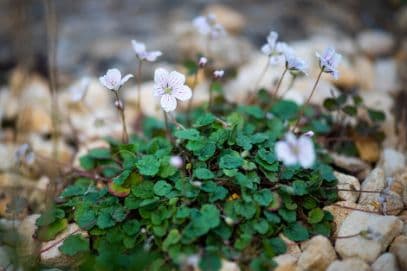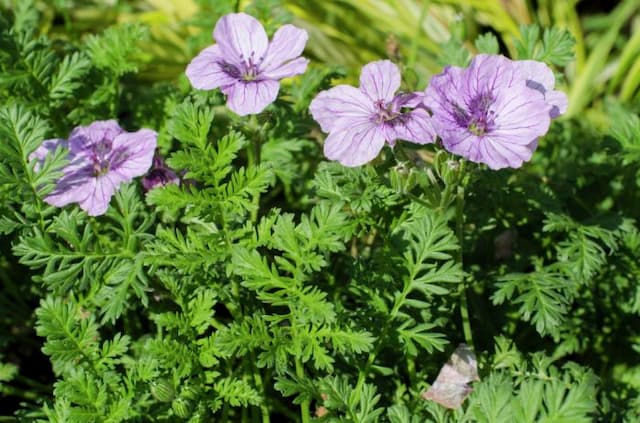Geranium Orkney Cherry Geranium Orkney Cherry = 'Bremerry' (PBR)
![cranesbill [Orkney Cherry]](/_next/image?url=https%3A%2F%2Fplants-admin.emdemapps.com%2Fimages%2Fplants%2F%2Fimages%2F604b5dad09c9c.png&w=3840&q=75)
ABOUT
The Geranium Orkney Cherry, commonly known as the Orkney Cherry Geranium, is a striking perennial characterized by its vivid and colorful appearance. This plant produces an abundance of flowers that are a rich, deep pink with darker veining, creating a stunning contrast against the lighter background of each petal. The flowers typically have a rounded shape, with five distinct petals that create a pleasing, symmetrical form. Foliage on the Geranium Orkney Cherry is lush and dense, contributing to the plant's robust look. The leaves are broadly rounded with a lobed edge, giving them a textured and somewhat ruffled appearance. Their color is a vibrant green which provides a lush backdrop for the bright blooms. As the seasons change, so too does the appearance of the Orkney Cherry Geranium. The foliage can take on a reddish or bronze tinge in the autumn, adding another layer of visual interest to the plant. Throughout its blooming period, its bright and cheerful flowers are likely to attract pollinators such as bees and butterflies, which adds a dynamic aspect to its appearance. In summary, the Geranium Orkney Cherry is an eye-catching plant with rich pink flowers and vibrant green foliage that adds a splash of color and life wherever it is planted. Its ability to change hues with the seasons further enhances its visual appeal, making it a favorite among gardeners looking for long-lasting beauty.
About this plant
 Names
NamesSynonyms
Orkney Cherry Geranium, Bremerry Geranium
Common names
Geranium Orkney Cherry, Pelargonium 'Bremerry'.
 Toxicity
ToxicityTo humans
Generally, members of the geranium family are not known to be toxic to humans. However, it is always wise to exercise caution and avoid ingesting plants not meant for consumption, as individual reactions can vary, and there is always the potential for gastrointestinal discomfort or allergic reactions in susceptible individuals.
To pets
Geraniums, including the Orkney Cherry geranium, can be toxic to pets such as dogs and cats. If ingested, they may cause symptoms such as vomiting, diarrhea, depression, anorexia, and occasionally dermatitis. It is advisable to keep this plant out of reach of pets to prevent possible poisoning.
 Characteristics
CharacteristicsLife cycle
Perennials
Foliage type
Deciduous
Color of leaves
Varies
Flower color
Pink
Height
1 foot (30 cm)
Spread
1 foot (30 cm)
Plant type
Herb
Hardiness zones
5
Native area
Europe
Benefits
 General Benefits
General Benefits- Low Maintenance: The Geranium Orkney Cherry is known for requiring minimal care, making it ideal for both novice and busy gardeners.
- Drought Tolerant: It can tolerate periods of dry weather, which is particularly useful in regions with water restrictions or less frequent rainfall.
- Attracts Pollinators: The blooms attract beneficial insects such as bees and butterflies, which are essential for pollination and maintaining a healthy ecosystem.
- Colorful Blooms: With its striking cherry-colored flowers, this plant provides a vibrant pop of color to gardens, borders, and containers.
- Extended Flowering Period: The Geranium Orkney Cherry offers a long flowering season, often from spring to the first frost, ensuring lasting beauty in the garden.
- Versatile: This variety is suitable for a range of garden situations, including borders, ground cover, and container planting.
- Deer and Rabbit Resistant: It is generally resistant to browsing by deer and rabbits, reducing the need for protective measures.
- Winter Hardy: It can withstand colder temperatures, making it suitable for a variety of climates and extending its growing range.
 Medical Properties
Medical PropertiesThis plant is not used for medical purposes.
 Air-purifying Qualities
Air-purifying QualitiesThis plant is not specifically known for air purifying qualities.
 Other Uses
Other Uses- The tightly packed foliage of Geranium 'Orkney Cherry' can be used as a natural dye, providing colors that range from greens to browns depending on the mordant used.
- The Geranium 'Orkney Cherry' can be planted as a living mulch under taller plants to suppress weeds and maintain soil moisture.
- When dried, the leaves of Geranium 'Orkney Cherry' can be incorporated into potpourri mixes for a subtle fragrance and decorative appearance.
- The durable Geranium 'Orkney Cherry' can be used in topiary gardens to create small-scale designs due to its compact growth habit.
- In culinary arts, sugared Geranium 'Orkney Cherry' petals can be used as edible decorations for desserts and cakes, although they should be consumed in moderation.
- Petals of Geranium 'Orkney Cherry' may be frozen in ice cubes to create visually striking additions to summer beverages.
- Geranium 'Orkney Cherry' can serve as a natural insect repellent in the garden, deterring pests with its aromatic foliage.
- The plant can be used in sensory gardens, where its textured foliage and colorful flowers provide tactile and visual stimuli for visitors.
- Geranium 'Orkney Cherry' can be utilized in educational gardens to teach about plant growth habits, pollination, and the importance of perennial plants in ecosystems.
- When used in companion planting, Geranium 'Orkney Cherry' can help attract beneficial insects, such as bees and butterflies, which aid in the pollination of surrounding vegetable and fruit crops.
Interesting Facts
 Feng Shui
Feng ShuiGeraniums can be used to promote positive energy in Feng Shui. Their bright colors and rounded shapes are seen as an embodiment of good Feng Shui because they symbolize happiness and good health. Place geraniums in areas of your home where you want to invite in these qualities, such as living rooms or patios, but avoid placing them in the bedroom, as they are considered too yang (active) for restful spaces.
 Zodiac Sign Compitability
Zodiac Sign CompitabilityGeraniums are not used in astrology practice.
 Plant Symbolism
Plant Symbolism- Unexpected Meeting: The Geranium symbolizes an unexpected encounter, due to its spontaneous growth and ability to pop up in unexpected places.
- True Friendship: Traditionally, Geraniums are associated with friendship, representing strong bonds and deep connections.
- Good Health: Geraniums are often linked with wishes for good health, as they have been used in folk medicine and are appreciated for their hardy nature.
- Favor and Goodness: The Geranium's enduring nature and vibrant blooms can represent a person's positive qualities and the good things that life offers.
 Water
WaterHardy Geraniums like the Orkney Cherry should be watered deeply once a week, allowing the soil to dry out between waterings. This encourages their roots to grow deeply, making them more drought-resistant. During hot and dry spells, increase watering to twice a week. Each watering should consist of about 1-2 gallons of water for outdoor garden plants, ensuring even soil moisture without waterlogging. Overwatering can lead to root rot, so adjust your watering regimen according to rainfall and soil drainage.
 Light
LightHardy Geraniums, including the Orkney Cherry, thrive best in full sun to partial shade. They perform well when they receive at least 6 hours of sunlight daily, but they can also tolerate light shade — especially in hot climates where some afternoon shade can prevent scorching. An ideal spot for these geraniums is a location that gets morning sunlight and some afternoon protection.
 Temperature
TemperatureHardy Geraniums like the Orkney Cherry are suitable for a wide range of temperatures, thriving comfortably in zones where temperatures typically range between 60°F and 75°F. They can tolerate a minimum temperature of around 20°F but may die back and enter dormancy below this point. Conversely, they can endure summer highs up to 90°F, but it's best if they are not exposed to such heat for prolonged periods.
 Pruning
PruningPruning Hardy Geraniums, like the Orkney Cherry, encourages bushier growth and improved flowering. Deadhead spent blooms regularly to promote continuous blooming and cut back the entire plant by a third after the first wave of flowering to rejuvenate the plant for a second bloom. The best time for major pruning is in late summer or early fall once the plant has finished blooming.
 Cleaning
CleaningAs needed
 Soil
SoilThe Geranium Orkney Cherry prefers well-draining soil with a mix of peat, perlite, and compost to provide a rich blend. It thrives best at a soil pH ranging from 6.0 to 7.5, ensuring slightly acidic to neutral conditions. Regular potting mix amended with organic material can also be suitable for this plant.
 Repotting
RepottingGeranium Orkney Cherry should typically be repotted every 1-2 years or when it has outgrown its current pot. Choose a container slightly larger than the previous one to allow for growth, ideally during the spring season.
 Humidity & Misting
Humidity & MistingGeranium Orkney Cherry does well in average room humidity levels, around 40-60%. They do not require high humidity environments, making them suitable for typical home conditions.
 Suitable locations
Suitable locationsIndoor
Ensure bright, indirect light and consistent moisture.
Outdoor
Place in sun to part-shade, protect from extreme cold.
Hardiness zone
5-9 USDA
 Life cycle
Life cycleGeranium 'Orkney Cherry' begins its life cycle with seed germination, typically in early spring under the right moisture and temperature conditions. After sprouting, the seedling will establish itself, developing a small rosette of leaves and a root system. As the plant matures, it enters the vegetative growth stage where it produces larger leaves and stems, expanding its presence in the garden space. This perennial then reaches the flowering stage, often in late spring or early summer, producing bright pink flowers that attract pollinators and add aesthetic value. Following the blooming period, the plant will set seed, completing its reproductive cycle, though 'Orkney Cherry' is often reproduced vegetatively via cuttings or division. Finally, the plant enters a period of dormancy in the fall and winter, conserving energy to re-emerge the following spring.
 Propogation
PropogationPropogation time
Spring-Summer
The Geranium Orkney Cherry, commonly known as cranesbill, can be propagated through stem cuttings, a method widely regarded as the most popular owing to its effectiveness and simplicity. This practice is ideally undertaken during the growing season, primarily in spring or early summer. To propagate by cuttings, a healthy stem about 4 to 6 inches (10 to 15 centimeters) long is selected, ensuring it has at least three leaf nodes. Cut the stem just below a leaf node with a clean, sharp pair of scissors or pruning shears, and remove the leaves from the lower half of the cutting. Dip the cut end in rooting hormone to enhance root development. The cutting is then planted in a well-draining potting mix, making sure to keep the soil consistently moist but not waterlogged. Roots typically begin to establish within a few weeks, after which the new plant can be gradually acclimated to outdoor conditions if climate permits.




![Cranesbill [Blue Sunrise]](/_next/image?url=https%3A%2F%2Fplants-admin.emdemapps.com%2Fimages%2Fplants%2F%2Fimages%2F604b638d45948.png&w=640&q=75)




